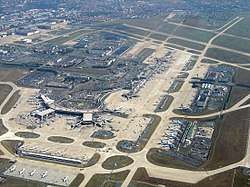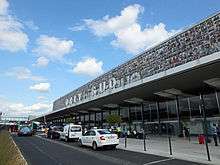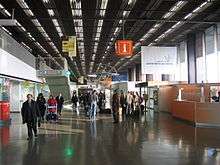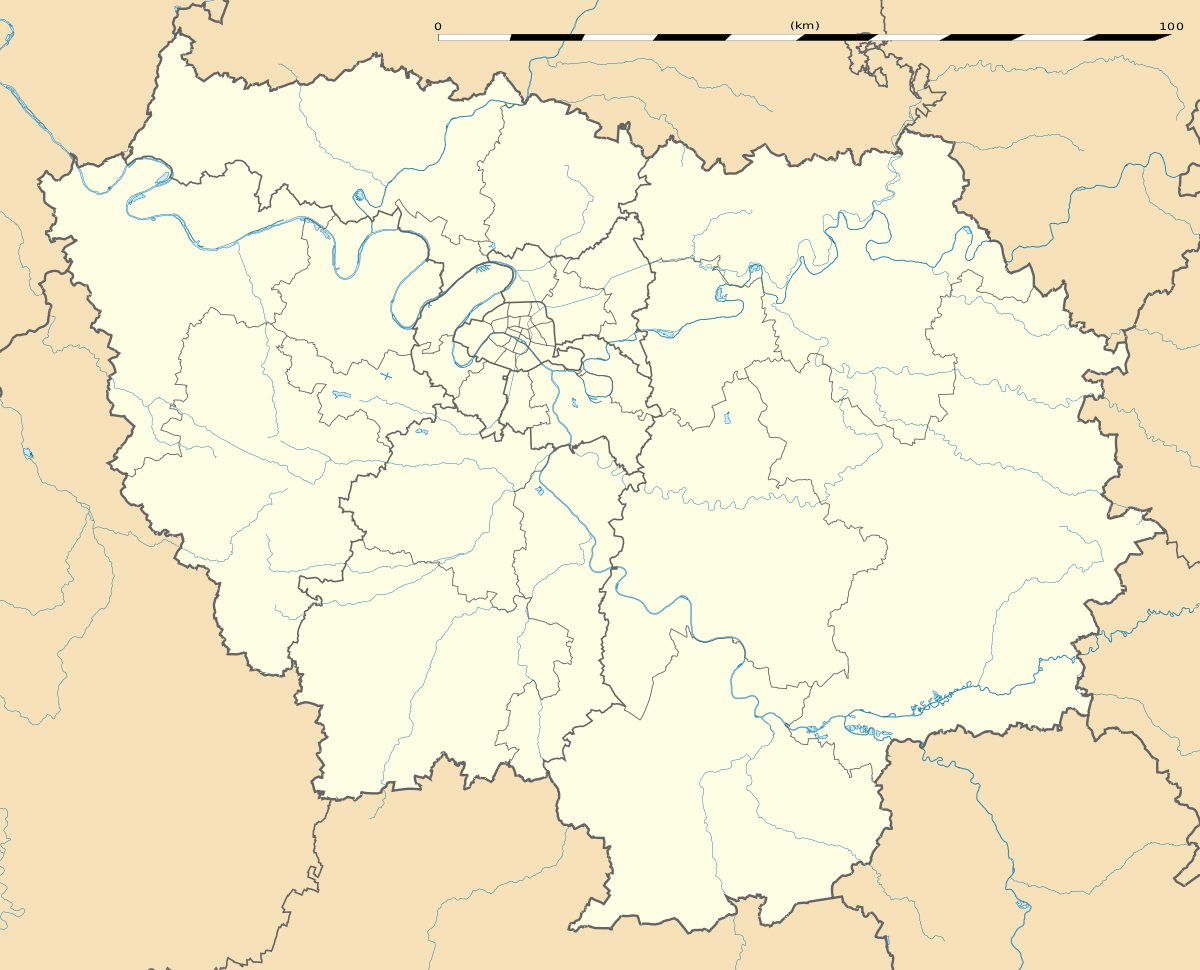Orly Airport
Paris Orly Airport (French: Aéroport de Paris-Orly), commonly referred to as Orly (IATA: ORY, ICAO: LFPO), is an international airport located partially in Orly and partially in Villeneuve-le-Roi, 13 km (8.1 mi) south[2] of Paris, France.
Paris Orly Airport Aéroport de Paris-Orly | |||||||||||||||||||
|---|---|---|---|---|---|---|---|---|---|---|---|---|---|---|---|---|---|---|---|
 | |||||||||||||||||||
 | |||||||||||||||||||
| Summary | |||||||||||||||||||
| Airport type | Public | ||||||||||||||||||
| Operator | Groupe ADP | ||||||||||||||||||
| Serves | Paris, France | ||||||||||||||||||
| Location | Essonne and the Val-de-Marne | ||||||||||||||||||
| Hub for | |||||||||||||||||||
| Focus city for | |||||||||||||||||||
| Elevation AMSL | 291 ft / 89 m | ||||||||||||||||||
| Coordinates | 48°43′24″N 02°22′46″E | ||||||||||||||||||
| Website | parisaeroport.fr | ||||||||||||||||||
| Map | |||||||||||||||||||
| Runways | |||||||||||||||||||
| |||||||||||||||||||
| Statistics (2019) | |||||||||||||||||||
| |||||||||||||||||||
It serves as a secondary hub for domestic and overseas territories flights of Air France and as the homebase for Transavia France. Flights operate to destinations in Europe, the Middle East, Africa, the Caribbean, North America, East Asia and Southeast Asia.
Prior to the opening of Charles de Gaulle Airport in March 1974, Orly was the main airport of Paris. Even with the shift of most international traffic to Charles de Gaulle Airport, Orly remains the busiest French airport for domestic traffic and the second busiest French airport overall in passenger traffic, with 33,120,685 passengers in 2018.[3] The airport is operated by Groupe ADP under the brand Paris Aéroport. Since February 2018, the CEO of the airport has been Régis Lacote.
Location
Orly Airport covers 15.3 square kilometres (5.9 sq mi) of land. The airport area, including terminals and runways, spans over two départements and seven communes:
- Essonne département: communes of Paray-Vieille-Poste (West Terminal and half of South Terminal), Wissous,[4] Athis-Mons,[5] Chilly-Mazarin,[6] and Morangis;[7]
- Val-de-Marne département: communes of Villeneuve-le-Roi[8] and Orly (half of South Terminal).[9]
Management of the airport, however, is solely under the authority of Aéroports de Paris, which also manages Charles de Gaulle Airport, Le Bourget Airport, and several smaller airports in the suburbs of Paris.
History
First years
Originally known as Villeneuve-Orly Airport, the facility was opened in the southern suburbs of Paris in 1932 as a secondary airport to Le Bourget. Before this two huge airship hangars had been built there by the engineer Eugène Freyssinet from 1923 on.
World War II
As a result of the Battle of France in 1940, Orly Airport was used by the occupying German Luftwaffe as a combat airfield, stationing various fighter and bomber units at the airport throughout the occupation.[10] Consequently, Orly was repeatedly attacked by the Royal Air Force and United States Army Air Forces (USAAF), destroying much of its infrastructure, and leaving its runways with numerous bomb craters to limit its usefulness to the Germans.
After the Battle of Normandy and the retreat of German forces from the Paris area in August 1944, Orly was partially repaired by USAAF combat engineers and was used by Ninth Air Force as tactical airfield A-47. The 50th Fighter Group flew P-47 Thunderbolt fighter-bomber aircraft from the airport until September, then liaison squadrons used the airfield until October 1945.[11]
Post-war
The USAAF diagram from March 1947 shows the 6,140-foot (1,870 m) 27/207 (degrees magnetic) runway (later 03R) with 5,170-foot (1,580 m) 81/261 runway (later 08L) crossing it at its north end. The November 1953 Aeradio diagram shows four concrete runways, all 197 feet (60 m) wide: 03L 7,874 ft (2,400 m), 03R 6,069 ft (1,850 m), 08L 5,118 ft (1,560 m) and 08R 6,627 ft (2,020 m).
The American United States Army Air Forces 1408th Army Air Force Base Unit was the primary operator at Orly Field until March 1947 when control was returned to the French Government. (The United States Air Force leased a small portion of the Airport to support Supreme Headquarters Allied Powers Europe (SHAPE) at Rocquencourt). The Americans left in 1967 as a result of France's withdrawal from NATO's integrated military command, and all non-French NATO forces were asked to leave France.[12]
In May 1958, Pan Am Douglas DC-7Cs flew to Los Angeles in 21 hr 56 min; TWA, Air France and Pan Am flew nonstop to New York in 14 hrs 10–15 min. Air France flew to Tokyo in 31 hr 5 min via Anchorage or 44 hr 45 min on a seven-stop Lockheed Constellation (1049G model) via India. Air France's ten flights a day to London were almost all Vickers Viscounts; the only other London flight was Alitalia's daily Douglas DC-6B (BEA was at Le Bourget).
A development project voted in 2012 planned to merge the airport's south and west terminals with the construction of an 80,000-square-metre (860,000 sq ft) building to create one great terminal.[13] On 14 April 2016, the Groupe ADP rolled out the Connect 2020 corporate strategy and the commercial brand Paris Aéroport was applied to all Parisian airports, including the Orly airport.[14]
As part of the COVID-19 pandemic and its impact on aviation, the airport was closed to all commercial traffic from April 1st, 2020, to June 25th, 2020. Flights were redirected to the Charles de Gaulle Airport. During this time, the airport was still used for State flights, emergency diversions, and medical evacuations.
Terminals

Terminals 1 and 2
Known as the West Terminal until March 2019, these two Terminals consist of two floors and a gate area of four "fingers" rather than a brick-style layout. The ground level 0 features the arrivals facilities including 8 baggage reclaim belts as well as several service facilities and shops. The departures area is located on level 1 with more stores and restaurants located here. This central departures area is connected to three gate areas split between Orly 1 (A and B gates) and Orly 2 (C gates) .[15] 23 stands at this terminal are equipped with jet-bridges, with several of them also able to handle wide-body aircraft.[16]
Terminal 3
Inaugurated in April 2019, Terminal 3 is a junction building between Terminals 1, 2 and 4. The terminal allows customers to travel between all areas of the airport under one roof. It includes around 5,000 sqm of Duty Free shopping along with several restaurants and lounges. It houses gates D and E, with direct access to Orly 4 departure gates.[17]
Terminal 4
Formerly known as the South Terminal this innovative 1961 steel-and-glass terminal building consists of six floors. While the smaller basement level −1 as well as the upper levels 2, 3 and 4 contain only some service facilities, restaurants and office space, level 0 features the arrivals facilities as well as several shops and service counters. The airside area and departure gates are located on the upper level 1. The waiting area, which features several shops as well, houses gates E and F.[15] 15 of the terminal's departure gates are equipped with jet-bridges, some of them are able to handle wide-body aircraft.[16]
Airlines and destinations
Other facilities
AOM French Airlines had its head office in Orly Airport Building 363 in Paray-Vieille-Poste.[21][22][23] After AOM and Air Liberté merged in 2001,[24] the new airline, Air Lib, occupied building 363.[25]
Ground transportation




Train
- Orly Airport is connected to the RER B train line at Antony train station by the Orlyval automatic shuttle. Orlyval is free to use between the two Orly terminal stations (Orly 4 and Orly 1,2,3), however it costs €9.30 between Antony and Orly Airport.
- Tramway T7 connects Orly 4 to Villejuif – Louis Aragon on Paris Métro Line 7.
- A shuttle connects Orly Airport to the RER C train at Pont de Rungis – Aéroport d'Orly.
- Paris Métro Line 14 is being extended to Orly. Opening of the extension is foreseen in 2024.
- The airport will also serve as a terminus for the future Paris Métro Line 18, due to enter service in 2026.
Car
Orly Airport is connected to the A106 autoroute (spur route of the A6 autoroute).
Buses and coaches
- the RATP buses:
- Orlybus direct to Denfert-Rochereau
- 183 to Porte de Choisy
- Le Bus Direct coaches:
- Line 1 to the place Charles de Gaulle through Gare Montparnasse
- Line 3 to Charles de Gaulle Airport
- the Albatrans buses:
- 91.10 to gare de Saint-Quentin-en-Yvelines through gare de Massy-Palaiseau
- the Athis Cars buses:
- 8 to gare de Villeneuve-Saint-Georges through gare d'Ablon
- 191.100 to the Marché international de Rungis and gare d'Yerres through gare de Juvisy
- the VEA buses:
- a shuttle direct to Disneyland Paris
- the Noctilien night buses:
- N22 to Place du Châtelet in Paris and gare de Juvisy
- N31 to Paris-Gare de Lyon
- N131 to Paris-Gare de Lyon and gare de Brétigny-sur-Orge
- N144 to gare de Paris-Est and gare de Corbeil-Essonnes
Accidents and incidents
- On 10 February 1948, SNCASE Languedoc P/7 F-BATH of Air France was damaged beyond economical repair at Orly Airport.[26]
- On 3 June 1962, Air France Flight 007, a chartered Boeing 707 named the Chateau de Sully bound for Atlanta, US, crashed on take-off with 132 people on board; 130 of them were killed. The only survivors were two stewardesses seated in the rear of the plane. The charter flight was carrying home Atlanta's civic and cultural leaders of the day. At the time, this was the highest recorded death toll for an incident involving a single aircraft.
- On 11 July 1973, Varig Flight 820, a Boeing 707, made a forced landing due to fire in a rear lavatory, incoming from Rio de Janeiro–Galeão. The aircraft landed 5 kilometers short of the runway, in a full-flap and gear down configuration. Due mainly to smoke inhalation, there were 123 deaths whilst 11 people survived (10 crew, 1 passenger).[27][28]
- On 3 March 1974, Turkish Airlines Flight 981, in an event known as the "Ermenonville air disaster", crashed in Ermenonville forest after take-off from Orly on a flight to London's Heathrow Airport when an improperly closed cargo door burst open. The explosive decompression that resulted brought down the McDonnell Douglas DC-10. All 346 people on board were killed, making the accident one of the deadliest in aviation history.
See also
References
Citations
- LFPO – PARIS ORLY. AIP from French Service d'information aéronautique, effective 13 August 2020.
- "EAD Basic – Error Page". Retrieved 2 June 2015.
- "Aéroport de Paris – Orly". Les Aéroports Français, Statistiques annuelles (in French). Paris: Union des aéroports Français. Archived from the original on 5 September 2017. Retrieved 28 July 2016.
- "Plan de Wissous Archived 2010-08-16 at the Wayback Machine." Wissous. Retrieved on 6 October 2009.
- "Plans, cartes et vue aérienne." Athis-Mons. Retrieved on 6 October 2009.
- "Plan interactif Archived 2007-06-17 at the Wayback Machine." Chilly-Mazarin. Retrieved on 6 October 2009.
- "Plan Archived 2009-11-04 at the Wayback Machine." Morangis. Retrieved on 6 October 2009.
- "Plan de la ville Archived 2009-06-29 at the Wayback Machine." Villeneuve-le-Roi. Retrieved on 6 October 2009.
- "Plan d'Orly Archived 2008-11-18 at the Wayback Machine." Orly. Retrieved on 6 October 2009.
- "The Luftwaffe, 1933–45". Retrieved 2 June 2015.
- Johnson, David C. (1988), U.S. Army Air Forces Continental Airfields (ETO), D-Day to V-E Day; Research Division, USAF Historical Research Center, Maxwell AFB, Alabama.
- McAuliffe, Jerome J. (2005). US Air Force in France 1950–1967. San Diego, California: Milspec Press, Chapter 14, Paris-USAF Operations. ISBN 978-0-9770371-1-7.
- Julien Chadeyron (25 October 2012). "The new face of Orly airport in 2018!". Mister10.com. Retrieved 22 March 2018.
- Charlotte Turner (19 April 2016). "ADP reveals rebrand and opens Orly South Pier". Trbusiness.com. Retrieved 22 March 2018.
- "Terminal maps". Retrieved 2 June 2015.
- [Google Maps]
- "Orly 1 2 3 4". www.parisaeroport.fr.
- "Air Caraïbes ajoute Cancun à son réseau | Air Journal".
- Liu, Jim (14 August 2020). "French Bee moves New York launch to early-Oct 2020". Routesonline. Informa Markets. Retrieved 14 August 2020.
- Liu, Jim. "S7 Airlines plans Moscow – Paris service from late-June 2020". Routesonline. Retrieved 13 April 2020.
- "World Airline Directory 1999." Flight International. 2000. 363.
- "Nos coordonnées agences en "France Métropolitaine "." AOM French Airlines. Retrieved on 15 May 2010. "SIEGE Bâtiment 363 B.P. 854 94 551 ORLY AEROGARE CEDEX"
- "Résultat de votre recherche." Le Journal officiel électronique authentifié. Retrieved on 15 May 2010. "Siège social : compagnie Air Lib, bâtiment 363, zone centrale à l’aéroport d’Orly, 91550 Paray-Vieille-Poste."
- "Découvrir Air Liberté." Air Liberté. 23 February 2002. Retrieved on 15 May 2010. "Le 22 Septembre 2001, AOM et AIR LIBERTE ont donné naissance à une nouvelle compagnie aérienne qui porte désormais le nom AIR LIB."
- "World Airline Directory." Flight International. 12–18 March 2002. 57.
- "F-BATH Hull-loss description". Aviation Safety Network. Retrieved 27 February 2014.
- "Accident description PP-VJZ". Aviation Safety Network. Retrieved 22 September 2011.
- Germano da Silva, Carlos Ari César (2008). "No céu de Paris". O rastro da bruxa: história da aviação comercial brasileira no século XX através dos seus acidentes 1928–1996 (in Portuguese) (2 ed.). Porto Alegre: EDIPUCRS. pp. 285–290. ISBN 978-85-7430-760-2.
Bibliography
- McAuliffe, Jerome J.: U.S. Air Force in France 1950–1967 (2005), Chapter 14, "Paris-USAF Operations".
External links
![]()
![]()



